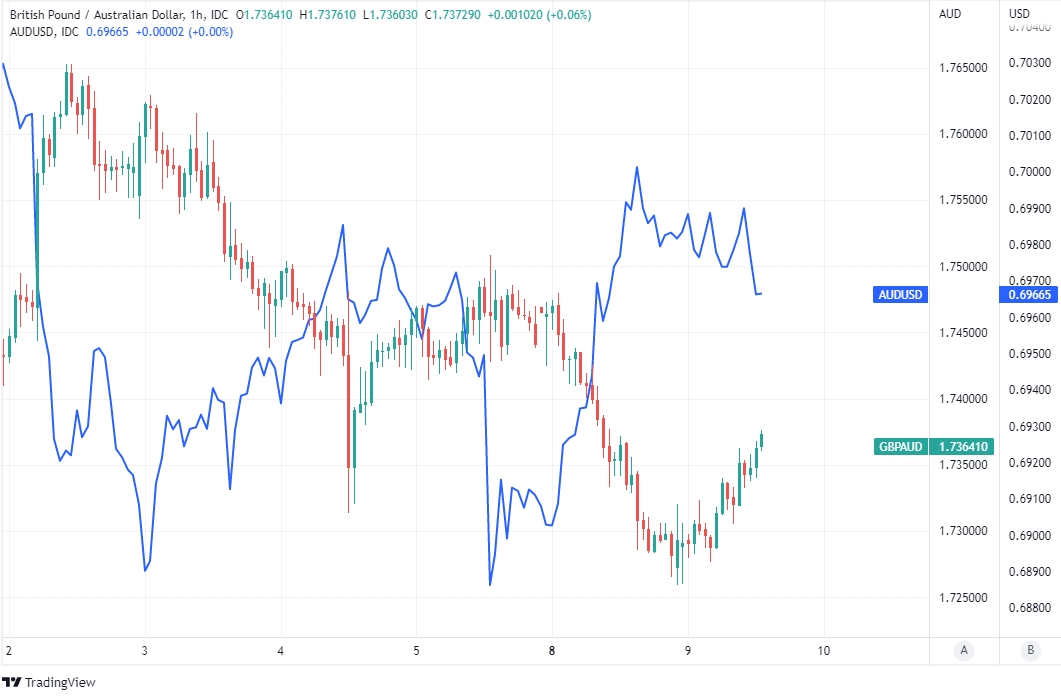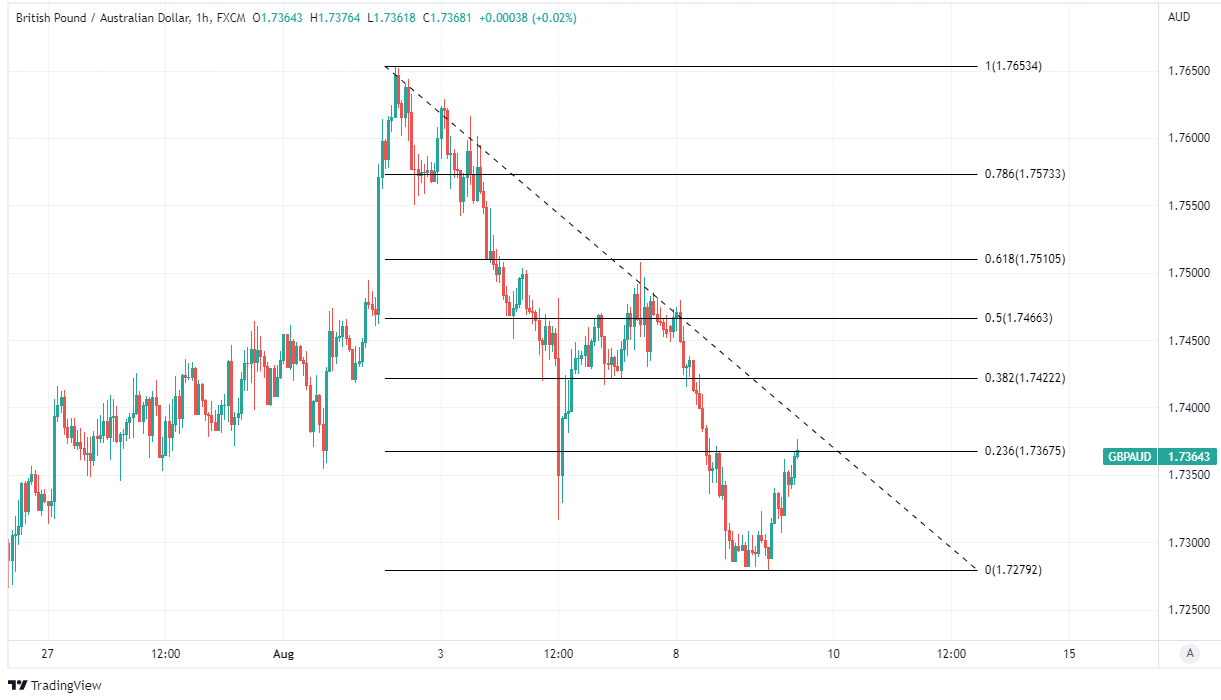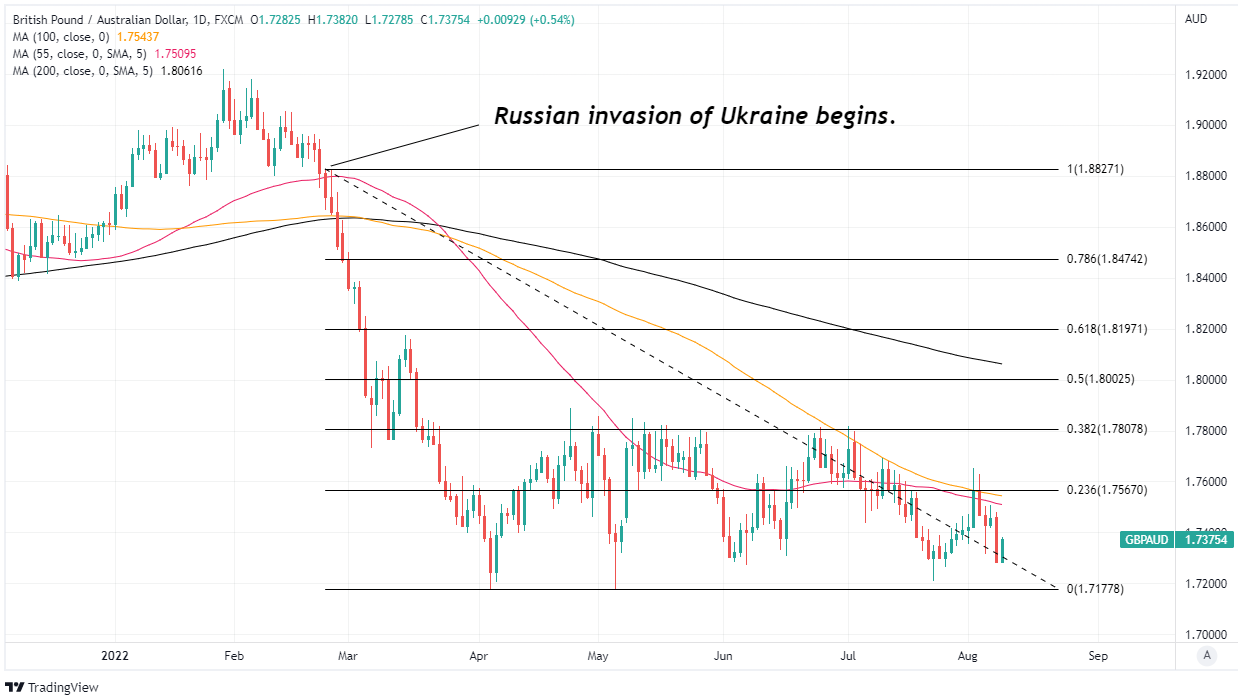GBP/AUD Recovery Could Meet Resistance Near and Above 1.75
- Written by: James Skinner
- Australian winning streak pushes GBP/AUD near 2022 lows
- Buoyant Aussie could curb GBP/AUD rebounds around 1.75
- U.S. CPI data, USD key in quiet week for UK, AU calendars

Image © Adobe Images
The Pound to Australian Dollar exchange rate opened the new week with losses that have pushed it back toward 2022 lows amid a tentative outperformance by the antipodean currency that could see GBP/AUD struggling to extend its Tuesday rebound once back near to the 1.75 level.
Sterling climbed against the Australian Dollar on Tuesday as European currencies appeared to be favoured heading into the mid-week session and release of U.S. inflation figures for July, which are the highlight of the week for the global currency market and a potential source of volatility.
But Tuesday’s gains were limited and still left the Pound to Australian Dollar rate near to 2022 lows that were approached on Monday when the U.S. Dollar handed some of its Friday gains back to other currencies and the Aussie outperformed many of its major counterparts.
“The low-key domestic calendar and peak northern summer vacation period suggests that US CPI will be key to A$ movements on the week,” says Sean Callow, a senior FX strategist at Westpac.
The Australian Dollar claimed second place in the G10 currency league table for the week to Tuesday and was competitive among G20 counterparts too.

Above: GBP/AUD shown at hourly intervals alongside AUD/USD. Click image for closer inspection.
Compare GBP to AUD Exchange Rates
Find out how much you could save on your pound to Australian dollar transfer
Potential saving vs high street banks:
A$48.75
Free • No obligation • Takes 2 minutes
Earlier Australian Dollar gains came hard on the heels of data showing China’s trade surplus rising to a new record in July, gains that were followed by a sharp fall in GBP/AUD during the opening session of the week.
But the Australian Dollar was tempered with GBP/AUD finding support after a survey from the Federal Reserve Bank of New York suggested that U.S. consumers’ inflation expectations eased lower for all time horizons in July.
“The latest consumer and business surveys show that both households and firms are reacting differently to rising interest rates and high inflation,” says Carol Kong, a currency strategist at Commonwealth Bank of Australia.
“Consumer sentiment extended its downtrend in August, falling to 81.2pts. By contrast, business confidence unexpectedly rose back above the long term average,” Kong and colleagues said of data released in Australia on Tuesday.
Meanwhile, Sterling has been an underperformer throughout the period of outperformance by the Australian Dollar and notably since the Bank of England (BoE) raised Bank Rate last Thursday but warned of an imminent recession that could run as deep and last for longer than those in the early 1990s and 1980s.
 Above: Pound to Australian Dollar rate shown at hourly intervals with Fibonacci retracements of early August decline indicating possible areas of short-term technical resistance. Click image for closer inspection.
Above: Pound to Australian Dollar rate shown at hourly intervals with Fibonacci retracements of early August decline indicating possible areas of short-term technical resistance. Click image for closer inspection.
This divergent performance is illustrated by the depth of the recent decline that pulled GBP/AUD back near to its 2022 lows over the week to Tuesday.
But with little by way of major appointments in the UK and Australian economic calendars this week, price action up ahead is likely to be most sensitive to the implications of Wednesday’s U.S. inflation figures.
“The greenback is holding in against the commodity currencies so far (CAD, AUD and NZD are mostly down or flat as I type this), but losing ground against EUR-area FX (including the NOK). The fortunes of the USD this week are largely tied to tomorrow’s CPI print and we expect markets to remain muted until then. Nonetheless, we continue to maintain a constructive bias for the USD,” says Bipan Rai, North American head of FX strategy at CIBC Capital Markets.
All currencies are sensitive to movements in the U.S. Dollar but the Aussie often tends to move faster and further in response to changes in its trajectory, and that is often reflected by GBP/AUD rising and falling alongside the U.S. Dollar.
This would have potentially bullish implications for GBP/AUD if Wednesday’s inflation figures force the financial markets to reconsider the outlook for Federal Reserve interest rate policy.
Above: GBP/AUD shown at daily intervals with selected moving-averages and Fibonacci retracements of late February decline indicating possible areas of short-term technical resistances for Sterling. Click image for closer inspection.
Compare GBP to AUD Exchange Rates
Find out how much you could save on your pound to Australian dollar transfer
Potential saving vs high street banks:
A$48.75
Free • No obligation • Takes 2 minutes
“Put simply, I’m sticking with core longs in the USD for now,” CIBC’s Rai said in a Tuesday market commentary.
“US data from last week was too strong – and not just nonfarms. ISM, factory orders, and final durables for June were all more constructive than I thought they’d be. At the very least, the slowdown in US real activity will be more drawn out than what markets were pricing,” he added.
It's possible, if not likely, that any further acceleration of the U.S. inflation rate for July would see a more aggressive interest rate response from the Fed priced-in, or a more protracted period over which it holds U.S. interest rates at their peak, which is widely expected to be reached in the final quarter of the year.
The rub for GBP/AUD is, however, that Sterling has repeatedly struggled to sustain rallies when back near to the 1.75 handle in recent weeks.
There is also a number of technical resistances up around that level including 55 and 100-day moving-averages and a bunch of Fibonacci retracement levels.
These could potentially frustrate a further recovery in the latter half of the week.





